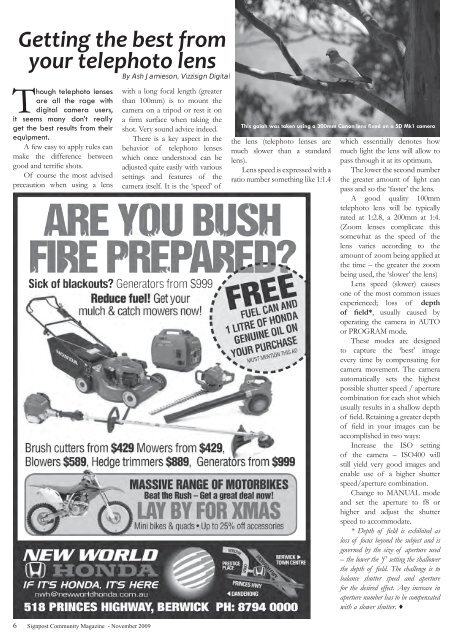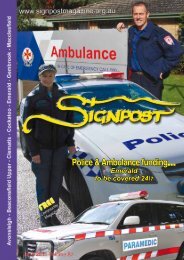You also want an ePaper? Increase the reach of your titles
YUMPU automatically turns print PDFs into web optimized ePapers that Google loves.
Getting the best from<br />
your telephoto lens<br />
By Ash Jamieson, Vizzisign Digital<br />
Though telephoto lenses<br />
are all the rage with<br />
digital camera users,<br />
it seems many don’t really<br />
get the best results from their<br />
equipment.<br />
A few easy to apply rules can<br />
make the difference between<br />
good and terrific shots.<br />
Of course the most advised<br />
precaution when using a lens<br />
6 <strong>Signpost</strong> Community <strong>Magazine</strong> - <strong>Nov</strong>ember <strong>2009</strong><br />
with a long focal length (greater<br />
than 100mm) is to mount the<br />
camera on a tripod or rest it on<br />
a firm surface when taking the<br />
shot. Very sound advice indeed.<br />
There is a key aspect in the<br />
behavior of telephoto lenses<br />
which once understood can be<br />
adjusted quite easily with various<br />
settings and features of the<br />
camera itself. It is the ‘speed’ of<br />
This galah was taken using a 300mm Canon lens fixed on a 5D Mk1 camera<br />
the lens (telephoto lenses are<br />
much slower than a standard<br />
lens).<br />
Lens speed is expressed with a<br />
ratio number something like 1:1.4<br />
which essentially denotes how<br />
much light the lens will allow to<br />
pass through it at its optimum.<br />
The lower the second number<br />
the greater amount of light can<br />
pass and so the ‘faster’ the lens.<br />
A good quality 100mm<br />
telephoto lens will be typically<br />
rated at 1:2.8, a 200mm at 1:4.<br />
(Zoom lenses complicate this<br />
somewhat as the speed of the<br />
lens varies according to the<br />
amount of zoom being applied at<br />
the time – the greater the zoom<br />
being used, the ‘slower’ the lens)<br />
Lens speed (slower) causes<br />
one of the most common issues<br />
experienced; loss of depth<br />
of field*, usually caused by<br />
operating the camera in AUTO<br />
or PROGRAM mode.<br />
These modes are designed<br />
to capture the ‘best’ image<br />
every time by compensating for<br />
camera movement. The camera<br />
automatically sets the highest<br />
possible shutter speed / aperture<br />
combination for each shot which<br />
usually results in a shallow depth<br />
of field. Retaining a greater depth<br />
of field in your images can be<br />
accomplished in two ways:<br />
Increase the ISO setting<br />
of the camera – ISO400 will<br />
still yield very good images and<br />
enable use of a higher shutter<br />
speed/aperture combination.<br />
Change to MANUAL mode<br />
and set the aperture to f8 or<br />
higher and adjust the shutter<br />
speed to accommodate.<br />
* Depth of field is exhibited as<br />
loss of focus beyond the subject and is<br />
governed by the size of aperture used<br />
– the lower the ‘f’ setting the shallower<br />
the depth of field. The challenge is to<br />
balance shutter speed and aperture<br />
for the desired effect. Any increase in<br />
aperture number has to be compensated<br />
with a slower shutter. ♦





